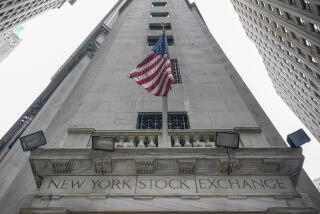Bankruptcy Filings at 1st-Quarter High
- Share via
A slowing economy, the rising tide of consumer debt, bankruptcy reform laws and falling stock prices pushed bankruptcy filings by businesses and individuals to their highest first-quarter level ever, according to statistics released Wednesday.
Bankruptcy filings rose to 366,841 in the first three months of 2001, up 17.5% from 312,335 filed during the first quarter of last year, according to figures released by the American Bankruptcy Institute.
That made it the worst quarter for bankruptcies since 1998’s second quarter, when 373,460 bankruptcies were filed, according to the ABI, an Alexandria, Va.-based think tank. It was also the most first-quarter bankruptcy filings since the group began compiling the data in the 1980s.
“The economic slowdown beginning last fall, combined with historic high levels of consumer debt, mean that filings will reach a new peak this year,” said Samuel J. Gerdano, executive director of ABI.
Reversing the trend of recent years, personal bankruptcy filings totaled 356,836 in the first quarter, up 17.8% from 302,879 in the first quarter of last year.
“Instead of a nation of savers, we’re a nation of borrowers, and this is the reflection of that,” said Kenneth N. Klee, a professor at UCLA who specializes in bankruptcy law. “Bankruptcies have dropped in the last few years, but are now on the upswing because of the economy.”
Others are seeing the same trend.
“We in the bankruptcy community are working harder and faster than we have since the real estate dip in California” in the early 1990s, said J. Scott Bovitz, a Los Angeles attorney and chairman of the State Bar of California’s personal and small-business bankruptcy committee. “In personal bankruptcies, much of this is due to the new [bankruptcy] laws.”
The overhaul of the federal bankruptcy code, which would fulfill a three-year campaign by banks and credit card companies to make it harder for consumers to walk away from their debts, will make bankruptcy more complicated and expensive. House and Senate versions of the bill must be reconciled before the overhaul becomes law.
With this law likely to go into effect in early 2002, some financially strapped consumers may be trying to beat the deadline by filing for bankruptcy now, analysts said.
The news was even more troubling on the corporate side, where the weakening U.S. economy is swelling the ranks of insolvent companies.
During the first quarter, corporate bankruptcy filings by public and private U.S. companies also increased, rising about 6% from the same time last year and nearly 19% during the first three months of this year compared with the fourth quarter of 2000.
More important, the rise continues a four-month trend in increasing business bankruptcies nationwide.
“Clearly, the trend makes one a bit uneasy,” said Jack Williams, the resident scholar at the American Bankruptcy Institute. “It’s still a small swath of data, but the trend in corporate bankruptcies is going the wrong direction.”
There were 10,005 corporate bankruptcies during the first quarter of this year, compared with 8,413 in the last quarter of 2000. There were 9,456 bankruptcies in the first quarter of 2000.
Annual business bankruptcies were on the upswing during most of the 1990s, peaking at 53,931 during 1997, and steadily falling in recent years. Total corporate bankruptcies were just 35,472 last year.
It’s the upward trend in corporate bankruptcies that makes analysts nervous. As many dot-coms fail and a volatile economy makes it tough for some firms to survive, business bankruptcies are expected to increase this year, analysts said. The energy crisis in California is expected to mean more small-business bankruptcies here, said experts such as Klee.
“Beauty shops, ice cream parlors, you’re going to see a lot of small businesses going under with the energy problems,” Klee said. “I don’t see the situation getting better, not in the short run anyway.”
With more companies struggling to stay afloat, corporate restructurings are on the rise. This is providing a business boom to lawyers and investment bankers who once worked on first-time stock sales and secondary stock offerings, as they shift their talents to restructuring troubled companies.
Many of these restructurings and possible mergers won’t pan out, however, and bankruptcy filings are expected to stay strong throughout this year.
“There are a lot of traditional and nontraditional companies on the cusp of insolvency, and if the economy doesn’t pick up, a lot of these will fall by the wayside,” Williams said.
The statistics released Wednesday include all types of personal and business bankruptcy filings: Chapter 7, used to liquidate assets and pay off debts for both individuals and businesses; Chapter 11, which allows businesses, and sometimes individuals, to reorganize their finances to pay off their debts; Chapter 12, used by insolvent family farmers; and Chapter 13, commonly used by individuals.
*
Times staff writer Liz Pulliam Weston contributed to this report.
(BEGIN TEXT OF INFOBOX / INFOGRAPHIC)
Going Broke
Prompted in part by a weakening economy and a volatile stock market, bankruptcy filings by individuals and U.S. companies have risen in the last year, reversing the trend of recent years. First-quarter 2000 figures compared with first-quarter 2001:
Personal bankruptcy filings
2000: 302,879
2001: 356,836
Corporate bankruptcy filings
2000: 9,456
2001: 10,005
Note: Figures include filings under chapters 7, 11, 12 and 13 of the U.S. Bankruptcy Code.
Source: American Bankruptcy Institute
More to Read
Inside the business of entertainment
The Wide Shot brings you news, analysis and insights on everything from streaming wars to production — and what it all means for the future.
You may occasionally receive promotional content from the Los Angeles Times.










